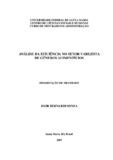| dc.creator | Sonza, Igor Bernardi | |
| dc.date.accessioned | 2017-04-12 | |
| dc.date.available | 2017-04-12 | |
| dc.date.issued | 2007-12-12 | |
| dc.identifier.citation | SONZA, Igor Bernardi. Efficiency analysis in the foodstuffs retailing sector. 2007. 192 f. Dissertação (Mestrado em Administração) - Universidade Federal de Santa Maria, Santa Maria, 2007. | por |
| dc.identifier.uri | http://repositorio.ufsm.br/handle/1/4520 | |
| dc.description.abstract | The concentration process restricted the Market Share of the retail sector of foodstuffs in a few companies, that have withhold a big part of the reserves. In accordance with ABRAS (2006), there is a large disparity among the participation of each format, the number of stores and the reserves of the foodstuffs retailing sector. In attention of this fact, it is perceptive that, in absolute terms, the hypermarkets possess advantage in relation to the supermarkets and the small markets, but not necessarily this logic is true in relative terms. Through the analysis of the DEA (Data Envelopment Analysis) it is possible to attribute weights to the variables considered and to determine the efficiency of the companies, thus identifying this relation. According to this point of view, the study in question aims at carrying through a comparative analysis between the size and the efficiency of the biggest foodstuffs retailing companies of Brazil through the DEA calculation, and to identify alternative targets for the less efficient companies. In the Kruskal-Wallis test, the null hypotheses of differences between size and efficiency was rejected, that is, it was found that the means are significantly different for the three groups (small, medium and large companies). Through the differences among means, it was also found that the large companies are more efficient, and that the medium companies possess advantage in terms of efficiency in relation to the small ones, with the exception of the analyses BCC and Superefficiency of model BCC, that had identified superiority of the small companies in relation to the medium ones. | eng |
| dc.format | application/pdf | por |
| dc.language | por | por |
| dc.publisher | Universidade Federal de Santa Maria | por |
| dc.rights | Acesso Aberto | por |
| dc.subject | Análise envoltória de dados | por |
| dc.subject | Supermercados | por |
| dc.subject | Eficiência | por |
| dc.subject | Data envelopment analysis | eng |
| dc.subject | Supermarket | eng |
| dc.subject | Efficiency | eng |
| dc.title | Análise da eficiência no setor varejista de gêneros alimentícios | por |
| dc.title.alternative | Efficiency analysis in the foodstuffs retailing sector | eng |
| dc.type | Dissertação | por |
| dc.description.resumo | O processo de concentração fez com que a Market Share do setor varejista de gêneros alimentícios ficasse concentrado em poucas empresas, as quais detêm grande parte do faturamento. De acordo com a ABRAS (2006), existe uma disparidade muito grande entre a participação de cada formato sobre o número de lojas e sobre o faturamento no ramo do varejo de gêneros alimentícios. Devido a esse fato, percebe-se que, em termos absolutos, as grandes redes varejistas de gêneros alimentícios possuem vantagem com relação às empresas de médio e pequeno porte, mas essa lógica não é necessariamente evidenciada em termos relativos. O estudo em questão realiza uma análise comparativa entre o porte e a eficiência das maiores empresas varejistas de gêneros Alimentícios do Brasil, através do Cálculo DEA, e identifica alvos alternativos para as empresas menos eficientes. Através do teste Kruskal-Wallis, foram rejeitadas as hipóteses nulas de que não existem diferenças entre o porte e a eficiência, ou seja, foi comprovado que as médias são significativamente diferentes para os três grupos de empresas (pequenas, médias e grandes). Através das diferenças entre Médias, foi comprovado que as empresas de grande porte são mais eficientes, e que as empresas de médio porte possuem vantagem em termos de eficiência com relação às de pequeno porte, com exceção para as análises BCC e supereficiência através do modelo BCC, que identificaram superioridade das empresas de pequeno porte com relação às de médio porte. | por |
| dc.contributor.advisor1 | Ceretta, Paulo Sergio | |
| dc.contributor.advisor1Lattes | http://lattes.cnpq.br/3049029014914257 | por |
| dc.contributor.referee1 | Marion Filho, Pascoal José | |
| dc.contributor.referee1Lattes | http://lattes.cnpq.br/6357528016447284 | por |
| dc.contributor.referee2 | Terra, Paulo Renato Soares | |
| dc.contributor.referee2Lattes | http://lattes.cnpq.br/6074785373968238 | por |
| dc.creator.Lattes | http://lattes.cnpq.br/0001554374469356 | por |
| dc.publisher.country | BR | por |
| dc.publisher.department | Administração | por |
| dc.publisher.initials | UFSM | por |
| dc.publisher.program | Programa de Pós-Graduação em Administração | por |
| dc.subject.cnpq | CNPQ::CIENCIAS SOCIAIS APLICADAS::ADMINISTRACAO | por |


